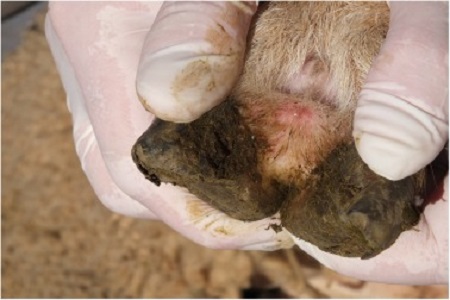
Foot rot is one of the most devastating diseases in the U.S. sheep industry. The most common clinical sign of foot rot or foot scald in sheep is simply limping sheep. Both scald and rot appear the same until you tip the sheep onto its rump and trim the hooves with a trimmer. This is where the difference lies. Foot rot will have undermined distorted hooves that when the outer surface is trimmed a deep hoof infection is obvious by the foul-smelling odor and soft necrotic appearance.
Foot scald on the other hand has no involvement of the hoof but is rather an infection in between the two claws (toes). If you trim feet of sheep that are affected by scald the hoof is normal in texture and appearance with the only abnormality on the inside of the claws. Foot rot is a synergistic infection of Bacteroides nodosus and Fusobacterium necophorum. Both are obligate anareobic bacteria that die in the presence of oxygen. B. nodosus is the contagious element of foot rot and is only found in sheep that are infected with foot rot or in the environment for only a short period of time (2 weeks). F. necrophorum is a normal inhabitant of soil and manure and can always be found where sheep are raised.
Foot scald (interdigital dematitis) is an infection of only F. necrophorum and is not contagious. It may appear contagious, however that is only because the environment is such (damp, muddy conditions) that more than one sheep will get infected. Treatment of foot rot should be approached from a flock standpoint. There are essentially two groups: the sheep that are infected and lame and the sheep that are not infected or sub-clinically infected (not lame). The lame sheep should be isolated, the feet should be trimmed to expose the infected tissue to oxygen, treated topically with kopertox and given an injection of long-acting penicillin or tetracycline. The non-lame group should be run through a footbath of zinc sulfate or formaldehyde every three weeks. This group should also be monitored for new cases and those new cases should be isolated and treated. Treatment of foot scald is not nearly as complex as the disease is not contagious. Rather the entire group can be kept together but it is critical to get the sheep to a dry pasture or yard. Topical treatment with kopertox is beneficial as is footbaths.
Provided by J. L. Goelz, D.V.M.
Related Articles & Free Email Newsletter Sign Up
10 Tips to Raise Healthier and More Profitable Sheep
Sheep Milk Offers High Yields and Great Taste
The 4 Main Causes of Pneumonia in Goats


Comment here